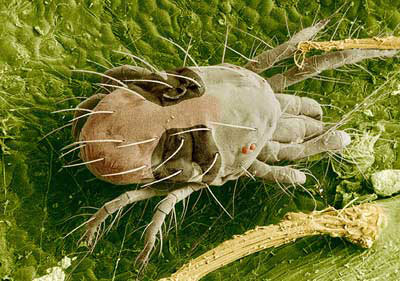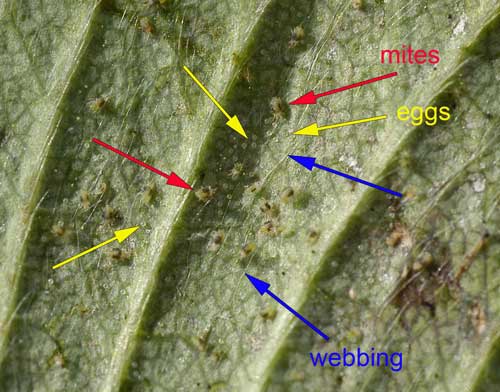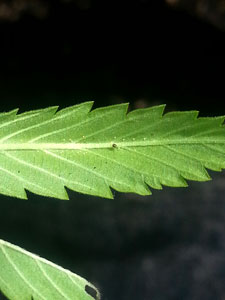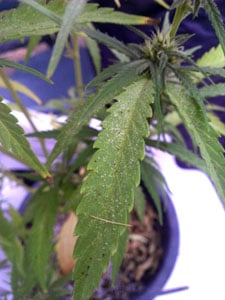Spider mites are part of the mite family and are related to spiders, ticks, and others. Although they’re a common cannabis pest, they can be difficult to eliminate. First Sign of Spider Mite Damage – Tiny Specks (Bite Marks) On Leaves.
Picture of spider mites on a cannabis leaf – they’re tiny and often found under the leaves

Spider Mites and Cannabis
Spider mites have tiny sharp mouths that pierce individual plant cells and suck out the contents. This results in tiny yellow, orange, or white speckles on your plant leaves.

Spider mites are common cannabis pests, especially when growing in soil. Although less common in hydroponics, spider mites can show up in any setup where cannabis is being cultivated!
Villains! Extreme Close-Up of Two-Spotted Spider Mites with Egg
Spider mites can be an especially tricky pest in the grow room. Since they are so small, they can build up a big infestation before a grower notices a mite. Many growers see the distinctive tiny spots of a spider mite infestation and think it’s some nutrient deficiency, not realizing it’s something far more sinister.
Growers despise spider mites. Here’s why:
- Rapid reproduction – a single mature female spider mite can produce a million mites in less than a month
- Disappearing act – spider mites often appear to be gone/killed; they come back with a vengeance days or weeks later, right when you thought you’d gotten rid of them for good.
- Big appetites – Spider mites can eat up your tender plants in an amazingly short amount of time; a bad infestation has been known to kill plants overnight
- Webbing – Spider mites cover leaves and buds with a fine mesh of silk webbing, ruining whole crops even after you get rid of the spider mites.
- Zombie-like resistance – spider mites quickly become immune to whatever you do to try to kill them; if you don’t take care of your spider mite problem by eradicating them from your grow room, you may soon find you have a population of’Super-mites’. The two-spotted spider mite, specializing in cannabis, seems particularly resistant to insecticides and is sometimes referred to as “the borg” in the cannabis-growing community. These ‘borg’ spider mites with two spots on their back can be almost impossible to eliminate!
Spider mites often go unnoticed at first because they are so tiny they look like spots to the naked eye. Male spider mites are about 1/50th of an inch long (.5mm), while females are slightly smaller at about 1/64 (.4mm). It’s hard to imagine something that tiny, but the picture below might help give you an idea of how small they are:
Under a microscope, they have four pairs of legs, no antennae and a body shaped like an oval.

When spider mites attack a particular spot, and you see many speckles near each other, the leaves may look yellow or bronze. Badly attacked leaves often die prematurely. Although it starts with speckles, this pest has earned the “spider” part of its name from the distinctive silk webbing they spin on vegetation, leaves, and flowers once an infestation sets in. Web-producing spider mites may completely coat the foliage and flowers with fine silk, which collects dust and looks dirty.
With flowering plants, you may even see entire buds get covered in fine webbing from a bad spider mite infestation.
Spider mites have a life cycle that helps them re-populate quickly and effectively after destroying much of their population. Adult females begin the cycle by laying eggs, often on their host plants. In days or weeks, an egg will hatch and become a larva, the first stage of life. Larvae are round-bodied and have only three pairs of legs. The larvae feed for a few days, seek a sheltered resting spot, and then molt into the first nymphal stage. The first nymph now has four pairs of legs. The first nymphs feed for a few days, rest, and molt into the second nymph. The second nymphs feed, rest, and molt into the adult stage. Overall, spider mites can take days or weeks to go through their whole life cycle.

Because of this variable growth process, it’s common to think you’ve eradicated the spider mites in your grow room while they’re secretly building up numbers in one of their immature stages. This is why it’s so important to keep treating your grow room after a spider mite infestation, even if it appears that all the spider mites are gone. Just pretend they’re hiding and doing pushups, just building up their numbers for a second infestation. Treat your grow room like a war zone, and don’t allow the spider mites to build up any numbers and attack again!
Growers Need to Take Spider Mites Seriously: Or This Can Happen!

Solution: Early detection of spider mites is key! Spider mites are tiny and can be detected only by a full and thorough leaf inspection (on both sides of the leaf). If you find Spider Mites or eggs, you must act fast and hit them hard. Spider mites can be very quick to take over your plant and even quicker to develop resistance to almost any method you use to get rid of them, which is why it’s generally recommended to use multiple methods of offense against a spider mite infestation. If you have problems with spider mites, keep a constant and varied offense for the best chance at success. It can help to identify how/where you got spider mites. If you already have an infestation, you will immediately want to start hitting them hard with something that will kill them on contact (several options are listed below). But…. First, what type of spider mite do you have?
- Tracked in from outside
- Vegetable garden
- Animals/pets
- From a plant other than marijuana
If you have some spider mites that got tracked in randomly from outside, you’ve likely got a run-of-the-mill spider mite that should be easy to get rid of.

Although these guys are annoying, they almost seem nice compared to their cannabis-specialized counterparts. Chances are you’ll be able to successfully use one of the less harsh home remedies to stop your infestation.
- From another marijuana garden
- Clones were infested with spider mites
- Tracked spider mites in from another marijuana garden
- Any time the spider mites were living on another marijuana plant before they got to your plants
If you got your spider mites from a cannabis clone or plant from another cannabis grower, chances are you’ve got the type of spider mite that is an expert at infesting cannabis plants. The (often two-spotted) mites often seem to be the worst spider mite in this category! These specialized spider mites are incredibly developed at living on marijuana plants and may already be immune to many common spider mite remedies. If you believe you got your spider mites from another marijuana grower, then don’t play games. Get serious and get rid of your mites before they adapt to your grow room and become unstoppable.
How To Get Rid of a Spider Mite Infestation
Step 1: Kill Them!
Step 2: Follow Up Again in 2-3 Days
Step 3: Repeat if Necessary
Step 4: Protect Your Plants
Step 1: Kill Every Spider Mite You Can Kill the Spider Mites! Here’s a list of proven spider mite remedies for cannabis plants (from home remedies to organic repellents to serious chemical pesticides)… Before your first treatment… Cut down their numbers!
- Control the heat
- Have lots of air blowing over the plants and top of growing medium
- Spray spider mites off the plants if you can
Spider mites like the heat and hate a windy environment. A cool breezy grow space won’t eliminate spider mites, but it makes it harder for them to reproduce so your other control methods are more effective. If you can bring your plants outside or somewhere safe, you might even consider spraying off as many spider mites as you can to get their numbers down before you start your main treatments. Get a fan blowing over the plants and top of the growing medium. Not only do plants grow better with a breeze, great air circulation is great for pest prevention. Spider mites love heat and stagnant, non-moving air. They can’t mate in windy conditions, so a strong fan can help keep the infestation from worsening. A breeze also helps pest treatments go better because fans help spray treatments dry on the plant. Azamax is a time-tested way to rid your grow room of spider mites. Spray plants 15 minutes before lights out, drenching the foliage under the leaves and the top of your soil. Use a fan to blow on your leaves to help things dry. Treat your room more than once, even if you believe the spider mites are gone. You can also add small amounts of Azamax when watering your plants, as it will not hurt your roots but kill spider mites in the soil. You will need a mister (a “One-Hand Pressure Sprayer”) to spray all the leaves evenly.

Spinosad Products (safe & organic, but not recommended for commercial growers) – Spinosad products are organic and, unlike many other spider mite pesticides, completely harmless to pets, children, and plants. Unlike many insecticides, you can spray spinosad heavily on leaves and roots without negative effects. Spinosad products can be used directly to kill spider mites on contact and when watering plants to kill spider mites via the roots systematically. Spinosad can also fight caterpillars, thrips, and many other marijuana pests. It can be used both as a topical spray like Azamax and Mighty Wash, and can also be used directly at the roots. Spinosad is an organic insecticide made from the fermentation of a specific soil bacteria (actinomycete Saccharopolyspora spinosa). It kills spider mites via ingestion or contact, affecting the insect’s nervous system. Spinosad can be a good choice for organic and outdoor growers because it is very toxic to spider mites but is less toxic to many beneficial arthropods. Note: Most spinosad products are effective only about 24 hours after being mixed with water, so only mix as much as you need per application. Anything left over will be wasted. You will need a mister (a “One-Hand Pressure Sprayer”) to spray all the leaves evenly.
Recommended: Monterey Garden Insect Spray with Spinosad
Essentria IC3 (organic) Essentria IC3 Insecticide is a mix of various horticultural oils that are organic and safe for humans. It is often marketed as a “bed bug killer,” but it can be effective against many bugs, including spider mites when the plants are treated regularly. Unfortunately, it only stays effective on the plant for about 8-12 hours, so you will want to either apply this daily or (better idea) combine it with other options. You will need a mister (a “One-Hand Pressure Sprayer”) to spray all the leaves evenly.


Insecticidal soaps Fatty acid salts or insecticidal soaps weaken the outer shell of spider mites but are safe for humans and don’t leave much of a residue. Coverage is very important with soaps as they do not stay on your plant for long, so follow-up applications may be necessary. Although this is considered safe, avoid getting any on your buds so it doesn’t affect the taste/smell!
Doktor Doom Spider Mite Knockout Spray This spray is hard on spider mites, but the main ingredient, Pyrethrum, can also be hard on plants, especially in tight spaces without much ventilation, so keep it as a last resort if possible. Use with extreme care around humans, as the ingredients can be toxic. Never use Pyrethrum-based products on your plants while your grow lights are on, as they can burn them. Avoid using Pyrethrum products on young or sensitive plants, as they can get burned even when the lights are off. Do cover your grow lights and vents when bombing your plants with Pyrethrum, and make sure you give the area at least 24 hours to air out before you try to breathe the air. This spray can work well for a couple of plants, but you’ll want a Pyrethrum fogger if you have a lot of plants to treat. Outdoors, Pyrethrum can kill beneficial insects, too, so keep that in mind if you’re using natural predators to control pests (like ladybugs). All that being said, this spray will work to get rid of most spider mites, and it kills them on contact. Pyrethrum kills spider mites but not their eggs, so this product must be used 2-4 times (once every 2-3 days) to stop the breeding cycle and eliminate the toughest infestations.
NoPest Strips These emit a vapor that kills spider mites but do NOT use these if you will be breathing air from your grow room as the vapor they give off is toxic to humans and other mammals. These are only suitable if you’re growing somewhere that is NOT your living space but can be an effective way to eliminate spider mites.

Floramite – Strong stuff with harsh chemicals, incredibly expensive, but it can often do the job when everything else fails. Use as directed and only as a last resort!

Bleach solution (1 tablespoon of bleach to 1 gallon of 95°F, pH balanced, water in a spray bottle or mister ) – make sure to clean all surfaces of your room, and bleach them too if possible. Alcohol and Water mixed together (9 parts water to 1 part alcohol) will also kill the bugs on contact and shouldn’t hurt the plant. You will want to use a spray bottle or mister . SM-90 mixed with water (1 part SM-90 to 5 parts water) kills spider mites on contact and is organic (it even smells good!). You will need a mister to get nice even coverage on all the leaves with SM-90. Note: SM-90 has been temporarily discontinued. Neem Oil works in a similar way to SM-90, though Neem oil doesn’t smell as nice and will leave an unpleasant taste/smell on buds when used to treat flowering plants. There’s some evidence Neem oil may be harmful to humans so use with care! Just as with SM-90, you will need a mister to get all the leaves evenly, especially since neem oil and water will separate easily. Insect predators – there are also insect predators such as ladybugs and predatory mites that can provide some control and reduce your spider mite numbers, but it is unlikely these will get rid of your spider mites on their own. Insect predators can be effective if you have a small problem or if you need to get to harvest and chemical sprays are not a good option. Diatomaceous Earth – Basically, this is fossil dust – sprinkle on the top of your soil, and anywhere else in your room (window sills, doorways, etc). This powder-like substance is harmless to mammals and plants but is incredibly sharp at the microscopic level. Therefore it will tear and dehydrate spider mites on physical contact. This will not get rid of an infestation but can help control and slow things down when used effectively.
Step 1: Treat Entire Grow Area With Insecticide, Not Just Plants! – Treat complete room with broad-spectrum insecticide (only do this for a really bad problem or one that keeps coming back) – avoid this if you can! Note: Many growers try to avoid chemical sprays or miticides which contain Abamectin or lindane because these are harmful to humans. Please take a look at anything you use to treat your grow room, follow the directions closely, and heed all warnings. Some treatments will work for some setups or types of mites, but not for others. As mentioned earlier, if you got your spider mites from another marijuana grower, chances are you may need to resort to extreme measures to get rid of your infestation.
Step 2: Follow up in 2-3 days with a different method to kill them (you should also re-apply your first method) Follow up in 2-3 days with something different that will also kill their eggs and any surviving adults. The adults at this point will already be more resistant to your original method so you’ll get the best results using something else for the second treatment.
Step 3: Repeat Step 1 & 2 at least one more time – always treat grow area at least once after you think spider mites are completely gone Repeat steps 1 & 2 at least one more time to ensure that you have really cleaned out your grow room. Some species of spider mite can take days or weeks to mature and will reappear in the grow room stronger than ever. Because of this, you should treat your area at least once after you are almost certain that all the spider mites are gone. Using a mix of several different methods seems to work best for getting rid of spider mites. Some spider mites are more resistant to some methods than others. If you can see spider mites with your eyes, it means you probably have millions in the room waiting to hatch.
Step 4: Prevention: thoroughly inspect and proof your grow area against future attacks Once spider mites are gone, you need to worry about prevention. With spider mites, the best offense is a good defense! Stop spider mites from ever getting hold of your grow room with good prevention….
Indoor Spider Mite Prevention
The best spider mite remedy is prevention! If you’ve had spider mite attack your grow room in the past, you might be unintentionally doing something to encourage or attract them. There are many preventative products such as sprays which make plants less tasty to annoying spider mites. However, these should only be used as a supplement to good gardening practices. The most important aspect of spider mite (or any marijuana pest) prevention when growing indoors is a clean and secure grow room.

Never Bring Spider Mites into Your Grow Room! Many indoor growers get spider mites from bringing in cannabis clones that are infected, or from visiting another grower or grow room with spider mites. Even just a few eggs on a clone or a few spider mites on your clothes is all it takes to start a full-fledged infestation. This is the most common way people get spider mites, especially the marijuana-specialist spider mites (“the borg”) which can be almost impossible to kill! Most importantly, never move plants or clones from the outside world into your grow room without treating and quarantining them. If you get a new plant, keep that plant away from your other plants until you know that it’s clean. For every new plant or clone:
- Get a handheld microscope to look for bugs on new plants. Check closely for tiny spots on the leaves which could be spider mite bites. Also, check for eggs and tiny bugs underneath the leaves. It’s easiest to find bugs when the plant is at its smallest.
- Dip new clones or small plants in room temperature water treated with Safer Soap or Mighty Wash
- If you can’t dip the plant, spray with a proven spider mite cure.
- Keep new plants in quarantine for at least a week and check regularly to ensure they have no bugs before you bring them around your other plants.
- Never go directly into the grow room from outdoors to avoid tracking in bugs. If you’ve visited another grower or grow room, changing your clothes and possibly showing before checking on your plants is especially important. You don’t want to infect your plants with spider mites that are cannabis specialists!
One of the cool things about growing with seeds is you never have to worry that they come with bugs! Keep a Clean Grow Space Try to keep everything clean and tidy. Not only does this help prevent bugs but it protects buds so they don’t have fibers and dust all over them!
- Collect any dead leaves or other plant matter regularly and remove them from your growing space. It doesn’t count if you put them in a neat pile or trash can in the corner, you need to keep dead plant matter out of your grow room.
- Ensure that you or anyone who enters your contact space is clean (don’t let anyone walk into your grow room directly from outside). Be especially cautious if the person has recently visited another grow space.
- No dogs, cats, rabbits, or other pets in your grow space. In addition to shedding and possibly bringing in bugs, some cats will happily chew on your leaves and buds, so double reason not to let them anywhere near your plants!
- Wipe up and sterilize everything in between grows.
Maintain a Great Growing Environment Spider mites do better in some environments than others. Luckily the conditions that make your plants happy are not that great for spider mites. So if you’re taking care of your plant’s environment, you’re also helping to prevent bugs and mold.
- Ensure you have great airflow in your room because spider mites thrive in stagnant air. Creating lots of air movement will not only help prevent spider mites, fungus gnats and mold, but your plants love it too!
- Spider mites like hot, dry weather. Maintaining a comfortable room temperature and moderate humidity in the grow room will help prevent or slow down a spider mite infestation.
- If you have an air intake from outside, make sure you have some filter to keep bugs from getting in
- Sprinkle Diatomaceous Earth on top of your soil and all around your grow room – this all-natural remedy is safe for humans (we can even eat it) and works because it is very jagged on the microscopic level. Tiny spider mites get ripped apart by diatomaceous earth while plants grow through it happily
Keep a close watch on your plants, and react quickly at the FIRST site of spider mites!!!! If you’re growing just a small amount of marijuana for personal use and are really worried about spider mites, you might consider starting with seeds instead of clones. That way you don’t have to worry about accidentally getting cannabis zombie mites when starting from seed (plus you can choose to grow any strain you want!). Another way to help prevent some pests is to grow hydroponically since spider mites and most pests are much less likely to thrive in a soilless environment!
Outdoor Spider Mite Prevention
If you have a spider mite problem outdoors, you will want to: Don’t Bring Infected Plants Into Your Garden. For every new cannabis plant or clone:
- Use a handheld microscope to look for bugs on any new plants. Check closely for tiny spots on the leaves, which could be spider mite bites. Also, check for eggs and tiny bugs underneath the leaves.
- Dip new clones or small plants in room temperature water treated with Safer Soap or Mighty Wash . If you can’t dip the plant, spray with a proven spider mite cure.
- Keep new plants in quarantine for at least a week and check regularly to ensure they have no bugs before you bring them around your other plants.
- If you’ve visited another cannabis grower, grow room or outdoor garden, changing your clothes and possibly showing before checking on your plants is especially important. You don’t want to infect your plants with spider mites that are already specialized in infecting cannabis plants!
Don’t Kill Beneficial Insects
- A healthy population of predatory insects like ladybugs will help kill off pests including spider mites. The “Western Predatory Mite” is another great defense against spider mites since they specialize in killing mites.
- Only use pesticides if you actually need them and avoid using broad-spectrum pesticides that kill lots of bugs indiscriminately. Instead, try to use narrow-spectrum pesticides meant to kill just the bugs you’re trying to eliminate. So for example, if you have caterpillars, use something that mostly kills just caterpillars (like BT Spray, which pretty much only kills things like caterpillars and fungus gnats) instead of using a pesticide that kills all kinds of bugs, including caterpillars. It will not only work better to get rid of the specific pest you’re having trouble with, but it also prevents you from possibly killing some predatory insects that may be protecting your garden.
Keep a close watch on your plants, and react quickly at the FIRST site of spider mites!!!!
